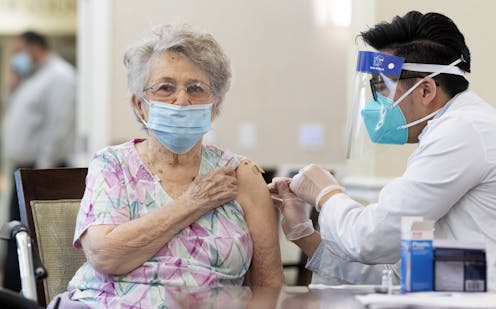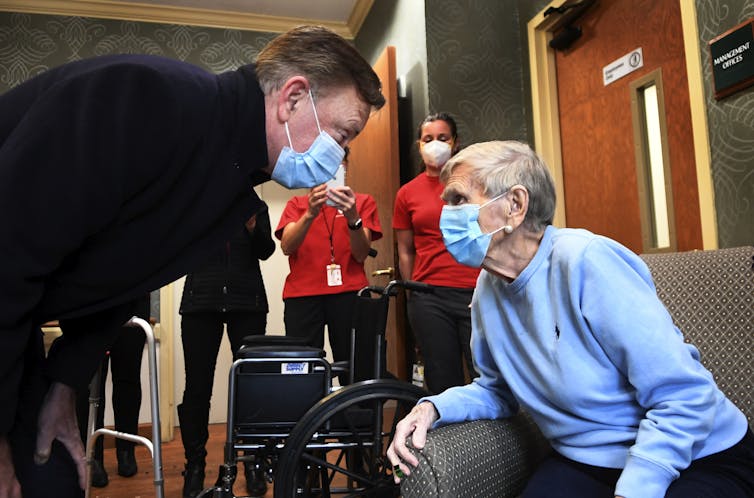The simple reason West Virginia leads the nation in vaccinating nursing home residents
West Virginia turned to its local pharmacies for help. Its program's success holds some important lessons for other states and the rest of the vaccine rollout.

The urgency of vaccinating nursing home residents is evident in the numbers. The COVID-19 pandemic has claimed the lives of more than 136,000 residents and employees of long-term care facilities in the U.S. alone, accounting for nearly 40% of all U.S. deaths linked to the disease.
Echoing that urgency, Secretary of Health and Human Services Alex Azar declared in mid-December, “We can have every nursing home patient vaccinated in the United States by Christmas.” Yet, by Christmas, most states had barely begun.
Other states were still far behind when West Virginia became the first state to finish round one of the two-dose vaccine series in nursing homes on Dec. 30.
What did West Virginia do differently?
The numbers tell a story. As a professor who specializes in health care operations management, I believe they hold some important lessons for other states and the rest of the vaccine rollout.
The pharmacy math problem
The first important point is that West Virginia opted out of a federal partnership program that relies on the giant CVS and Walgreens pharmacy chains to deliver vaccines to nursing homes. Instead, the state is relying on a network consisting mostly of local pharmacies.
West Virginia has also been praised for how it used the two weeks between the first vaccine authorization and when the first doses arrived to plan the rollout.
The big difference is in the numbers. Under the federal partnership program, CVS planned to have about 1,000 of its pharmacies as vaccine hubs to serve some 25,000 nursing home facilities across the nation, a CVS official told The Wall Street Journal in early December. Similarly, a Walgreens official said his company would have 800 to 1,000 Walgreens pharmacies to serve as hubs for about 23,000 nursing home facilities.
That meant each CVS and Walgreens pharmacy on average planned to serve about 25 nursing homes.
West Virginia chose to mobilize independent and chain pharmacies alike, rather than relying just on CVS and Walgreens. A total of 250 pharmacies participated in vaccinating 214 nursing homes. In other words, each nursing home on average is served by more than one pharmacy.
Vaccinating nursing homes is a very labor-intensive operation. Getting consent from residents and staffers is time-consuming and confusing. By Jan. 14, only about one-quarter of the vaccines distributed to nursing homes through the federal program had reached people’s arms, while West Virginia had started vaccinating new groups and administering second doses.
Incentives are another issue
In addition to lopsided math, there is a story of incentives.
Under the contracts signed with the U.S. Department of Health and Human Services, CVS and Walgreens essentially won the right to vaccinate about 99% of U.S. nursing homes that registered with the program. They had little incentive to commit a large number of pharmacies and people to the daunting task of vaccinating nursing homes.
In West Virginia, however, hundreds of local and other chain pharmacies were involved, and each had every incentive to provide speedy services so nursing homes would not walk away from the vaccination deals. Local pharmacies also often have existing relationships with nursing homes – relationships they want to keep.

Lessons for the rest of the country
What can other states learn from West Virginia’s success story?
First, to speed up the vaccine rollout, the U.S. needs to address the bottlenecks – the shortages of resources, especially staffing and points of distribution, needed for vaccination.
Second, incentives matter. In designing vaccination programs, it is important to ensure providers are motivated to commit resources to speed up vaccination. Market competition is a powerful mechanism to achieve that.
Third, state and local leadership can make a difference. While a lack of federal leadership has been cited as a reason for the slow vaccine rollout, West Virginia succeeded in vaccinating nursing homes because it could be more nimble outside the federal program. State and local leaders can succeed when they are held accountable and when they proactively manage the process.
The U.S. is only at the beginning of the COVID-19 vaccination process. Just over 3% of the country’s population had been vaccinated as of Jan. 13, and there are many challenges on the road ahead. The complex cold storage requirements of mRNA vaccines can make reaching rural areas difficult without careful planning and logistical support. Refusals to get the vaccine mean heard immunity can be harder to reach. These all have implications as vaccinations go on.
Tinglong Dai does not work for, consult, own shares in or receive funding from any company or organization that would benefit from this article, and has disclosed no relevant affiliations beyond their academic appointment.
Read These Next
Chile elects most right-wing leader since Pinochet – in line with regional drift, domestic tendency
José Antonio Kast, who has run for the presidency several times, successfully seized on widespread…
Epstein’s victims deserve more attention than his ‘client list’
Powerful men connected to Jeffrey Epstein are named, dissected and speculated about. The survivors,…
Pardons are political, with modern presidents expanding their use
Trump and Biden have issued pardons at a faster clip than their predecessors. Many of their decisions…






